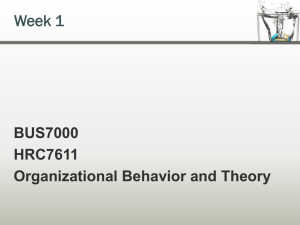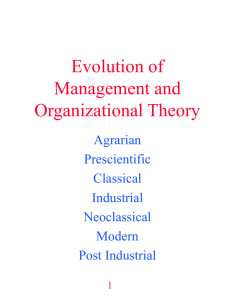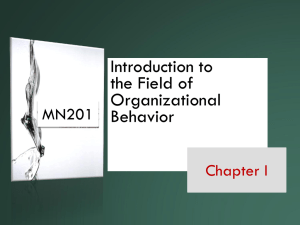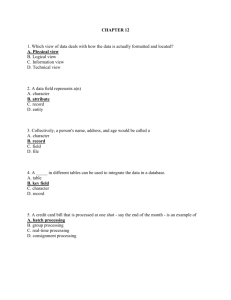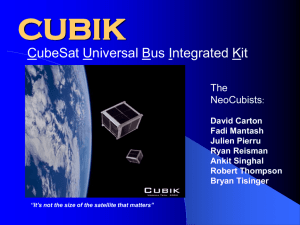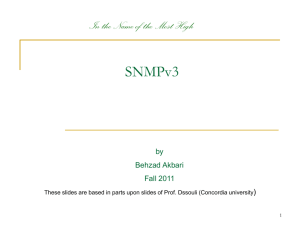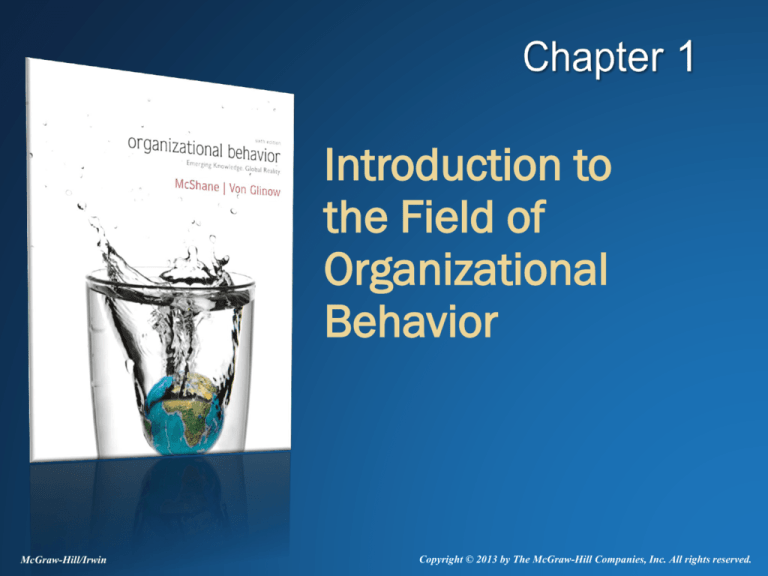
Introduction to
the Field of
Organizational
Behavior
McGraw-Hill/Irwin
Copyright © 2013 by The McGraw-Hill Companies, Inc. All rights reserved.
Practicing OB at Brasilata
Brasilata has become one of
Brazil’s most innovative and
productive companies by applying
organizational behavior
knowledge, including employee
involvement, creativity,
motivation, leadership, teamwork,
and organizational culture.
1-2
Organizational Behavior and
Organizations
Organizational behavior
• The study of what people think,
feel, and do in and around
organizations
Organizations
• Groups of people who work
interdependently toward some
purpose
• Collective entities
• Collective sense of purpose
1-3
Why Study OB?
Satisfy the need to understand and predict
Helps us to test personal theories
Influence behavior – get things done
OB improves an organization’s financial
health
OB is for everyone
1-4
Organizational Effectiveness
The ultimate dependent
variable in OB
Old approach -- achievement of
stated goals
Problem with goal attainment
• Could set easy goals
• Company might achieve wrong
goals
1-5
Four Perspectives of
Organizational Effectiveness
Open Systems Perspective
Organizational Learning Perspective
High-Performance WP Perspective
Stakeholder Perspective
NOTE: Need to consider all four perspectives
when assessing a company’s effectiveness
1-6
Open Systems Perspective
Organizations are complex systems that
“live” within (and depend upon) the external
environment
Effective organizations
• Maintain a close “fit” with changing conditions
• Transform inputs to outputs efficiently and flexibly
Foundation for the other three organizational
effectiveness perspectives
1-7
Open Systems Perspective
External
Environment
subsystem
•Raw materials
•Human
resources
•Information
•Finances
•Equipment
Technological
subsystem
Engineerin
g
subsystem
Transforming
Accounting
subsystem
inputs to outputs
Marketing
Managerial
subsystem
/Sales
subsystem
• Products/services
• Shareholder
dividends
• Community support
• Waste/pollution
Production
subsystem
Feedback
Feedback
1-8
Organizational Learning Perspective
An organization’s capacity to acquire, share,
use, and store valuable knowledge
Need to consider both stock and flow of
knowledge
• Stock: intellectual capital
• Flow: org learning processes
of acquisition, sharing, use,
and storage
1-9
Intellectual Capital
Human
Capital
Knowledge that people possess and
generate
Structural
Capital
Knowledge captured in systems and
structures
Relationship
Capital
Value derived from satisfied customers,
reliable suppliers, etc.
1-10
The Human Capital Advantage
Employee knowledge, skills, and abilities
Competitive advantage because:
• Helps discover opportunities and minimize threats
in the external environment
• Rare and difficult to imitate
• Nonsubstitutable: Not easily replaced by
technology
1-11
Organizational Learning Processes
Knowledge
Acquisition
Knowledge
Sharing
Knowledge
Use
Knowledge
Storage
• Learning
• Communication
• Awareness
• Human memory
• Scanning
• Training
• Sensemaking
• Documentation
• Grafting
• Info systems
• Autonomy
• Practices/habits
• Experimenting
• Observation
• Empowerment
• Databases
1-12
Organizational Memory
The storage and preservation of
intellectual capital
Retain intellectual capital by:
• Keeping knowledgeable employees
• Transferring knowledge to others
• Transferring human capital to
structural capital
Successful companies also unlearn
1-13
High-Performance Practices at
American Express
American Express encourages
employees to go “off script,”
meaning that they are
empowered to customize their
conversations rather than rely on
memorized statements. This
autonomy is one of several high
performance work practices.
1-14
High-Performance Work Practices
Workplace practices that leverage the
potential of human capital
Four HPWPs (likely others)
1. Employee involvement
2. Job autonomy
3. Employee competence (training, selection)
4. Performance-based rewards
Need to “bundle” them – work best together
1-15
Corporate Social Responsibility at
MTN Group in Africa
At MTN Group, Africa’s largest
mobile (cell) phone company,
employees help the community
and environment through the
company’s award-winning “21
Days of Y’ello Care” program.
This photo shows MTN
employees in Uganda planting
trees during a Y’ello Care event.
1-16
Stakeholder Perspective
Stakeholders: entities who affect
or are affected by the firm’s
objectives and actions
Personalizes the open systems
perspective
Challenges with stakeholder
perspective:
• Stakeholders have conflicting
interests
• Firms have limited resources to
satisfy all stakeholder needs
1-17
Stakeholders: Values and Ethics
Values and ethics prioritize stakeholder
interests
Values
• Stable, evaluative beliefs, guide preferences for
outcomes or courses of action in various situations
Ethics
• Moral principles/values, determine whether actions
are right/wrong and outcomes are good or bad
1-18
Stakeholders and CSR
Stakeholder perspective includes
corporate social responsibility
(CSR)
• Benefit society and environment
beyond the firm’s immediate
financial interests or legal
obligations
• Organization’s contract with
society
Triple bottom line
• Economy, society, environment
1-19
Globalization
Economic, social, and cultural connectivity
with people in other parts of the world
Improved communication and transportation
systems have increased globalization
Effects of globalization on organizations
• Cost efficiencies, innovation, knowledge
• Increasing diversity
• Increasing competitive pressures, intensification
1-20
Increasing Workforce Diversity
Surface-level vs deep-level
diversity
Implications
• Better knowledge, decisions,
representation, financial returns
• Manage challenges of diversity
(e.g. teams, conflict)
• Ethical imperative of diversity
1-21
Emerging Employment Relationships
Work/life balance
• Minimizing conflict between work and nonwork
demands number one indicator of career success
Virtual work
• Using information technology to perform one’s job
away from the traditional physical workplace
• Telecommuting – issues of social isolation,
emphasis on face time, employee self-leadership
1-22
Organizational Behavior Anchors
Systematic research anchor
• OB knowledge is built on systematic research
• Evidence-based management – decisions and
actions based on research evidence rather than
fads, hype, and untested assumptions
Multidisciplinary anchor
• Many OB concepts adopted from other disciplines
• OB develops its own theories, but scans other
fields
1-23
Organizational Behavior Anchors
(con’t)
Contingency anchor
• A particular action may have different
consequences in different situations
• Need to diagnose the situation and select best
strategy under those conditions
Multiple levels of analysis anchor
• Individual, team, organizational level of analysis
• OB topics usually relevant at all three levels of
analysis
1-24
Introduction to
the Field of
Organizational
Behavior

